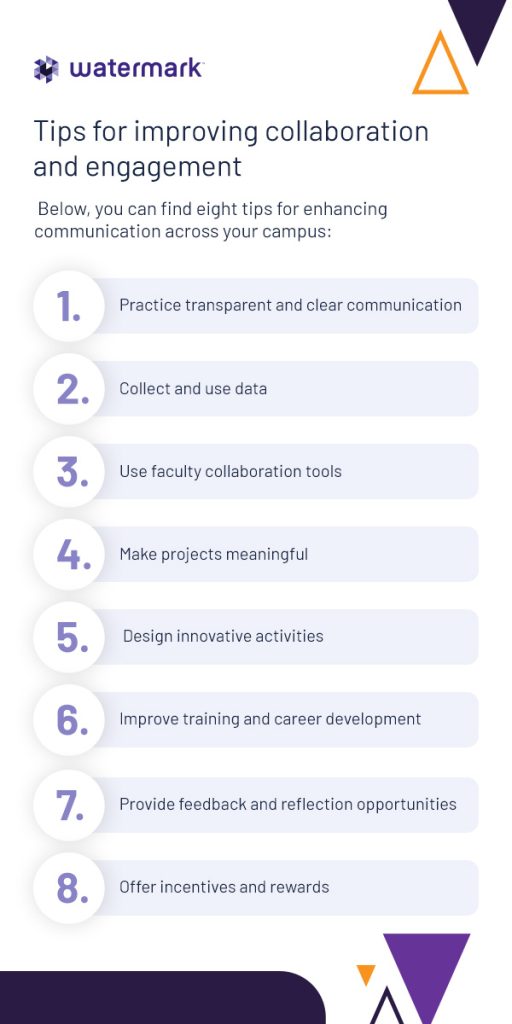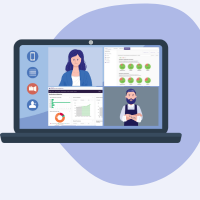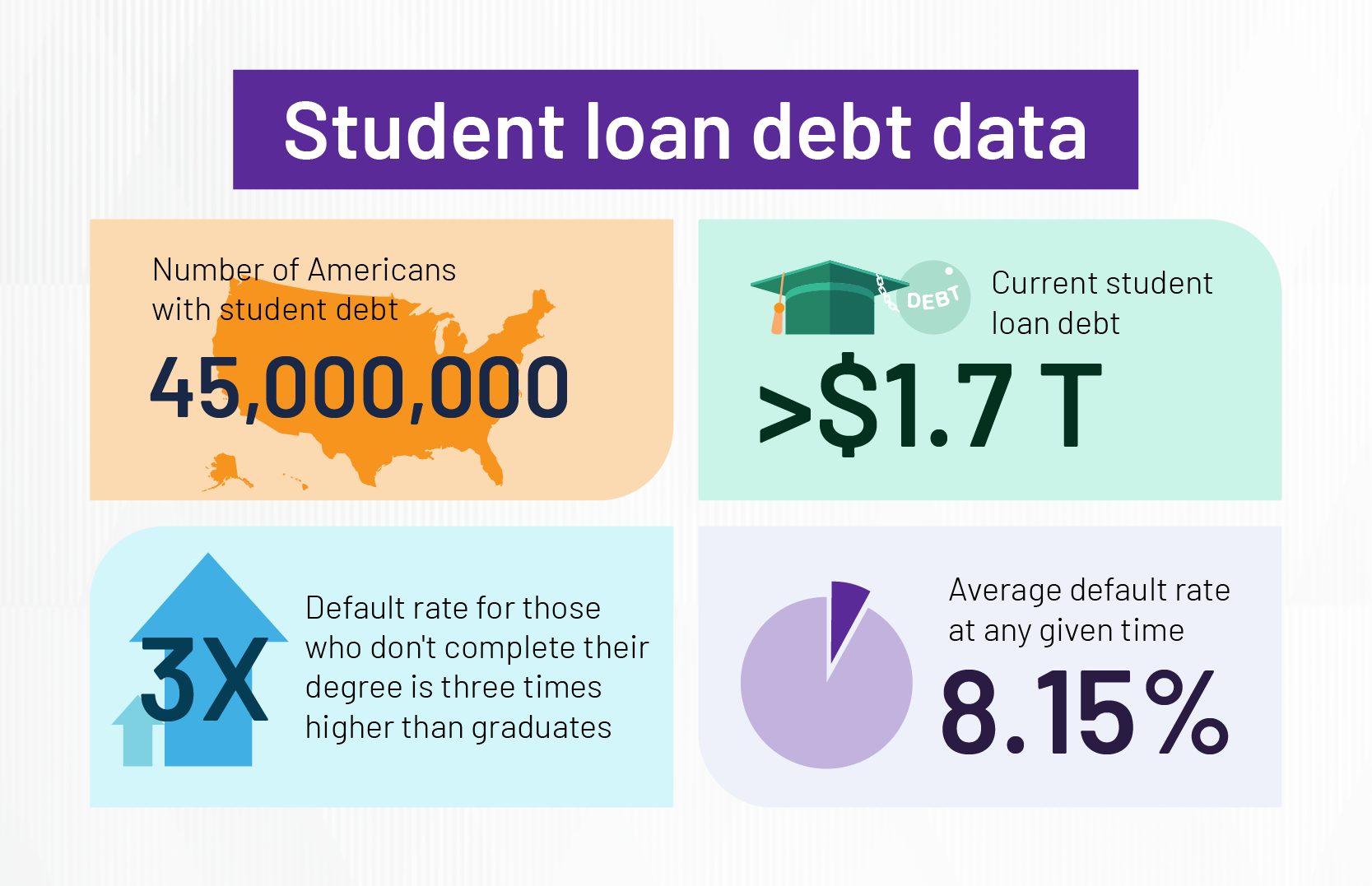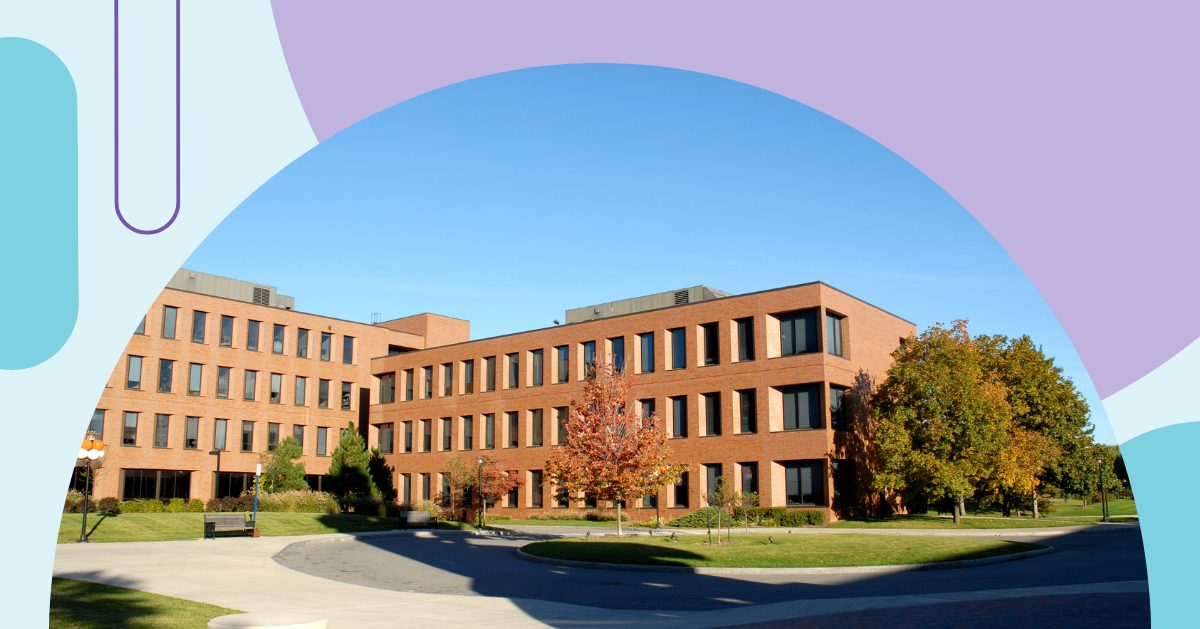
Collaboration is vital in higher education. Across departments and institutions, faculty members must be able to communicate with instructors, administrators, and decision-makers to foster an environment of continuous improvement. From teaching courses to facilitating research with other authors to working on accreditation projects, teams must work together and recognize the importance of a shared vision, unique experiences, and different knowledge sets to find unique solutions that improve student outcomes and aid in reaching institutional initiatives.
However, it can be easy to overlook this skill because many people assume it will develop over time or that team members will become more engaged as they learn on the job. When teams neglect the importance of collaboration, projects can suffer, departments can fail, and student outcomes can decline. Fostering faculty engagement and collaboration can be simple. Here, you can find eight strategies for enhancing collaboration at your institution.
The importance of faculty collaboration and engagement
Faculty engagement and collaboration have immense benefits for higher education institutions. These elements contribute to student success and empower more efficient teams. Additionally, increased collaboration across levels can boost employee satisfaction, encouraging faculty members to remain at your institutions for longer. With higher levels of satisfaction, your team can become more committed to growth at your institution and fuel future projects and discussions to drive institutional success and become more involved in student success.

Fulfilling faculty experiences on your campus can encourage instructors to work together to design cohesive programs, prompt faculty to know students more personally, and foster an environment where team members share knowledge, experiences, and ideas to further drive change.
Your faculty may also take the initiative to share findings with stakeholders and decision-makers as they become more comfortable in a collaborative environment. Instructors and other on-campus faculty members have direct relationships with your students and can often depict unique challenges students face and present solutions. With increased discussions, you can more quickly identify potential solutions to the problems you see on campus, further enhancing the student experience and fostering success.
Factors impacting academic collaboration
Several elements impact faculty collaboration and engagement. Understanding and identifying these elements is the first step toward breaking down any barriers:

- Compensation: Fair compensation can reduce excessive workplace stress and raise satisfaction levels. Faculty members who earn enough to support themselves are more likely to have improved emotional well-being and less financial stress that impacts their work. Additionally, a fair and reliable compensation process can promote a healthier work-life balance, encouraging faculty to develop healthier and happier habits to reduce stress.
- Development: A lack of developmental opportunities could contribute to a culture of monotony and leave your faculty feeling like their work has less meaning. Providing development opportunities such as learning and training sessions can empower your team to interact with new technology, modern strategies, and enhanced methods for completing various types of work.
- Physical office distance: Research has found a relationship between physical co-locations and scholarly collaboration. Findings highlight that placing faculty of the same discipline or related fields fosters more collaboration. The same study also found that moving two researchers into the same building increased their collaboration over time. While ensuring faculty members have adequate space for work, creating common areas and placing offices close to each other could prompt more discussions among colleagues.
- Task variety: Tasks that do not require specific skills or carry minor importance can make faculty feel less engaged. These types of tasks can increase the chances of faculty burnout and leave team members feeling dissatisfied. Balancing simple and complex tasks is vital for engagement and increasing interest while reducing anxiety and stress related to burnout. Assigning different types of tasks can also help your faculty view their work as more meaningful, creating a higher sense of purpose and satisfaction.
- Campus cultures: Students and faculty create unique campus cultures. Although these cultures can contribute to a positive environment, it is essential to ensure each group feels safe and secure on your campus and that different groups have opportunities to interact with each other. Collaboration between departments could help identify pain points and offer a foundation for addressing program needs.
- A lack of communication: Many times, faculty members do not engage in collaboration because they do not perceive the institution as having this supportive environment. Although you may verbally encourage your faculty and staff to collaborate, if they do not have this experience at your institution, they may be resistant to changing the culture. Taking an active role to encourage collaboration, such as hosting events, asking for feedback, and similar opportunities, can show your team that you value their engagement and want to see collaboration.
Tips for improving collaboration and engagement
After recognizing the importance of academic collaboration for higher education, you must identify areas where you and your team can improve. Taking simple steps can go a long way toward creating a more collaborative environment. Below, you can find eight tips for enhancing communication across your campus:

1. Practice transparent and clear communication
As a leader of your institution, it is essential to model the skills and expectations you want others to emulate and meet. Fostering collaboration starts with practicing it. Communicating with each team member and seeking opportunities to open the floor for discussion can spark a deeper sense of community and show your team how to meet collaboration expectations.
Celebrating the contributions of your faculty and contributing to a safe and inclusive environment can highlight your commitment to engagement and prompt team members to take further initiatives. You can also build a sense of community by assigning tasks to groups rather than individuals. Asking department members to work together throughout the curriculum mapping process, identify areas for program growth, and complete similar tasks is an excellent way to spark engaging faculty conversation while improving student outcomes.
2. Collect and use data
Data is power. Insights drive decision-making and allow you to see strengths and pain points at your institution. Sharing data with your team can help them see where their efforts make the most impact. Anytime you form a new objective or initiative, it’s important to express your thoughts and expectations and share team accomplishments as you get closer to completing your goals.
Evaluating data is also a great way to determine faculty growth opportunities, and these discussions can prompt team members to become more engaged as they navigate new methods to advance in their careers and refine their strategies. When performing faculty reviews, your team can be sure you recognize their accomplishments, and you can use your insights to make decisions about tenure, compensation, and similar elements.
3. Use faculty collaboration tools
Using tools to improve faculty collaboration is one of the best ways to engage your team while empowering them to leverage technology and advanced solutions to streamline workloads. The right collaboration tools can align your team with institutional projects and initiatives while providing helpful features like a shared calendar, chat boxes, and document uploading, editing, and sharing. These features make it easy for faculty members to interact on campus and after operational hours.
You can find solutions that enable group and individual project tracking, delegate tasks to the appropriate team members, and empower faculty to leverage resources and insights. Using these features can help you create a more fair and balanced workload across departments to prevent burnout and provide career-advancing opportunities to each faculty member seeking them. Additional features, such as faculty profiles, allow team members to share their accomplishments, showcase their work, and provide you with actionable insights to leverage during review processes.
4. Make projects meaningful
Meaningful projects will be much more exciting for your faculty than tedious or repetitive work. There are many opportunities to expand on your current operations while reinforcing meaning and highlighting your expectations to faculty. For example, curriculum mapping is most successful when teams thoroughly collaborate. Evaluate opportunities within your process to identify where you can enhance collaboration. Perhaps you host monthly meetings, create a central hub for program data and discussions, or ask faculty members to compare course materials to find overlaps in content.
You can also make work more meaningful with several strategies. For example, a project may feel more meaningful to your faculty if you assign a task to a group rather than an individual. You can also try implementing rewards or incentives for challenging work. Offering paid time off, one-time bonuses, and similar rewards can push faculty to put their best foot forward and find more meaning in their tasks. Additionally, receiving rewards and recognition for work can help faculty feel your appreciation for everything they do to improve your institution.
5. Design innovative activities
Designing unique activities and projects can create the necessary foundation for collaboration and engagement. Whether you choose to design simple or complex activities in formal or informal settings, you can craft meaningful experiences for team members while encouraging them to connect with each other. These activities or events are also great opportunities for implementing other strategies, such as career development opportunities. For example, a social event for a a specific department can include workshops and speaker sessions with free time for engagement with others in their field.
6. Improve training and career development
Many faculty members aim to grow in their careers through developmental opportunities and self-studies or projects. Along with empowering your team to access the latest technologies and interact with relevant field changes, these opportunities allow you to show your team your commitment to their growth.
This strategy can also impact student outcomes, as bringing these experiences and knowledge to campus can expand to students. For example, instructors can discuss new research methods or industry trends students will need to know for future careers. As your faculty navigates industry changes, they may engage in more discussion with colleagues and discuss opportunities for collaboration on upcoming projects or studies.
7. Provide feedback and reflection opportunities
Obtaining feedback is one of the best ways to identify strengths and areas for growth. Feedback should be a give-and-take process. Giving faculty feedback about their teaching methods, productivity, and accuracy can help them become a stronger team member.
By outlining your expectations and using data to support your feedback, you can provide actionable insights to engage faculty with their work and teams. Additionally, it is important to ask your faculty for feedback. Your staff members have unique experiences on campus and with students, empowering them to see problems and identify solutions you may not often interact with. Asking for faculty feedback can aid in decision-making and allow faculty to see that you care about their opinions and that their voices can make an impact.
8. Offer incentives and rewards
The possibility of monetary incentives or other worthwhile rewards can significantly increase collaboration and engagement. This strategy can help make tasks feel more meaningful and encourage faculty to go the extra mile to ensure accuracy and efficiency. Vacation days, travel stipends, paid time off, and similar rewards can be excellent incentives to complete a lofty goal. However, you can also implement smaller incentives to boost engagement for projects of all sizes. Praise and recognition can go a long way towards showing your team that you appreciate their efforts.
How Watermark can help you foster team collaboration
Collaboration is essential in higher education. When you need a comprehensive solution to gather deeper insights and foster a collaborative environment, you need a comprehensive solution that empowers your faculty and adapts as your institution grows.
Watermark Faculty Success provides a central hub for colleges and universities to store faculty activity data. This solution empowers teams to access deep insights into faculty contributions and allows you to support your team as they grow in their careers. You can use Faculty Success to:
- Share, upload, and edit documents
- Start conversations
- Schedule meetings
- Monitor project progress
- Evaluate workloads
- Highlight achievements
- And so much more
Faculty can streamline and lighten their workloads while prioritizing meaningful tasks and collaborating with teams to drive student and institutional success.
Support collaborative teams with Watermark Faculty Success
Watermark is your one-stop shop for driving institutional and student success. We build our solutions to suit the needs of higher education institutions, just like yours. By simplifying data collection and automating mundane tasks, we save time and empower faculty to engage in meaningful work that drives change.
Many institutions have already leveraged our solutions to drive campus changes and shape more collaborative and data-driven cultures. Are you ready to empower your team and enhance your collaborative processes? Request a demo of our Faculty Success solution to see how we can transform your institution.
















































































































































































































































































































































































































